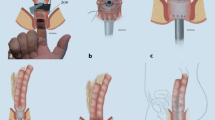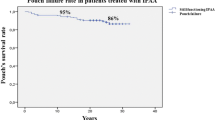Abstract
Background
Ileal pouch function is affected by several patient factors and pouch physiology. The significance of pouch physiology on optimal pouch function has not been well characterized. The purpose of this study was to examine specific post-ileal pouch anal anastomosis (IPAA) physiologic parameters to determine impact on pouch function and quality of life.
Methods
Patients undergoing proctocolectomy with IPAA for ulcerative colitis were examined. Post-IPAA compliance, pouch anal pressure gradient (PAPG), and function were assessed 6–8 months postoperatively. Compliance was calculated as change in volume divided by change in pressure. PAPG was calculated as the difference between anal pressure and intra-pouch pressure at a fixed volume. Pouch function evaluation included stool frequency and episodes of incontinence. Quality of life was evaluated using the Rockwood Fecal Incontinence Quality of Life Scale.
Results
A total of 125 patients were investigated. Post-IPAA resting anal pressure averaged 58.1 ± 15 mmHg. Mean volume and intra-pouch pressure at evacuation were 245 mL and 33.9 mmHg, respectively. Compliance averaged 11.2 mmHg/mL with a mean PAPG of − 29.3 mmHg. Compliance and PAPG correlated with 24-h (p = 0.003, p = 0.004) and nighttime stool frequency (p = 0.04, p = 0.03). Daytime continence was impacted by compliance (p = 0.04), PAPG (p = 0.02), and resting anal pressure (p = 0.02).
Conclusion
This unique evaluation reveals a significant correlation between IPAA physiologic properties and function. Optimal function and quality of life depend in part on maintaining optimal pouch compliance and pressure differentials between the pouch and anal canal, defined by the pouch anal pressure gradient.



Similar content being viewed by others
References
Fazio VW, Kiran RP, Remzi FH, Coffey JC, Heneghan HM, Kirat HT, Manilich E, Shen B, Martin ST. Ileal pouch anal anastomosis: analysis of outcome and quality of life in 3707 patients. Ann Surg. 2013;257(4):679-85.
Landisch R, Knechtges P, Otterson M, Ludwig K, Ridolfi T. Pouch volvulus in patients having undergone restorative proctocolectomy for ulcerative colitis: a case series. Dis Colon Rectum. 2018;61(6):713-718.
Naumann DN, Abbott S, Hall D, Bowley DM. Pouch dysfunction: don’t forget the surgeons! Frontline Gastroenterol. 2013;4(4):308-9.
Sunde ML, Ricanek P, Oresland T, Jahnsen J, Naimy N, Faerden AE. Determinants of optimal bowel function in ileal pouch-anal anastomosis - physiological differences contributing to pouch function. Scand J Gastroenterol. 2018;53(1):8-14.
Lewis WG, Miller AS, Williamson ME, Sagar PM, Holdsworth PJ, Axon AT, et al. The perfect pelvic pouch--what makes the difference? Gut. 1995;37(4):552-6.
Nasmyth DG, Johnston D, Godwin PG, Dixon MF, Smith A, Williams NS. Factors influencing bowel function after ileal pouch-anal anastomosis. Br J Surg. 1986;73(6):469-73.
Church J. The Implications of Pouch Physiology. Dis Colon Rectum. 2019;62(4):510-2.
Melvin JC, Janek K, Harms BA, Sanchez R, Heise CP. The Modern S-Pouch: “No Outlet” Design. Video abstract presentation ASCRS Annual Meeting 2019
Harms BA, Radosevich DG, Hamilton JW, Starling JR. A new technique and catheter design for assessing capacity and compliance characteristics of ileal reservoirs. Surg Gynecol Obstet. 1988;166(5):468-70.
Rockwood TH, Church JM, Fleshman JW, Kane RL, Mavrantonis C, Thorson AG, et al. Fecal Incontinence Quality of Life Scale: quality of life instrument for patients with fecal incontinence. Dis Colon Rectum. 2000;43(1):9-16; discussion -7.
Levitt MD, Lewis AA. Determinants of ileoanal pouch function. Gut. 1991;32(2):126-7.
Lindquist K. Anal manometry with microtransducer technique before and after restorative proctocolectomy. Sphincter function and clinical correlations. Dis Colon Rectum. 1990;33(2):91-7; discussion 7-8.
Takao Y, Gilliland R, Nogueras JJ, Weiss EG, Wexner SD. Is age relevant to functional outcome after restorative proctocolectomy for ulcerative colitis?: prospective assessment of 122 cases. Ann Surg. 1998;227(2):187-94.
Reissman P, Teoh TA, Weiss EG, Nogueras JJ, Wexner SD. Functional outcome of the double stapled ileoanal reservoir in patients more than 60 years of age. Am Surg. 1996;62(3):178-83.
Jorge JM, Wexner SD, James K, Nogueras JJ, Jagelman DG. Recovery of anal sphincter function after the ileoanal reservoir procedure in patients over the age of fifty. Dis Colon Rectum. 1994;37(10):1002-5.
Ramage L, Qiu S, Georgiou P, Tekkis P, Tan E. Functional outcomes following ileal pouch-anal anastomosis (IPAA) in older patients: a systematic review. Int J Colorectal Dis. 2016;31(3):481-92.
Taylor BM, Cranley B, Kelly KA, Phillips SF, Beart RW, Dozois RR. A clinic-physiological Comparison of ileal Pouch-Anal and straight Ileoanal Anastomoses. Ann Surg. 1983;198(4)462-8.
Klas J, Myers GA, Starling JR, Harms BA. Physiologic evaluation and surgical management of failed ileoanal pouch. Dis Colon Rectum. 1998;41(7):854-61.
Author information
Authors and Affiliations
Contributions
Joseph C Melvin, MD: conceptualization; data curation; formal analysis; methodology; writing, original draft; writing, review and editing.
Charles P Heise, MD: conceptualization; formal analysis; methodology; writing, original draft.
Glen E Leverson, PhD: formal analysis; methodology; writing, original draft; writing, review and editing.
Bruce Harms, MD: conceptualization; formal analysis; methodology; writing, original draft; writing, review and editing.
Evie Carchman, MD: conceptualization; data curation; formal analysis; methodology; writing, original draft; writing, review and editing.
Corresponding author
Ethics declarations
This study was approved by the University of Wisconsin Institutional Review Board (2015-1531).
Conflicts of Interest
The authors declare that they have no conflict of interest.
Additional information
Publisher’s Note
Springer Nature remains neutral with regard to jurisdictional claims in published maps and institutional affiliations.
This manuscript was a podium presentation at the American Society of Colon and Rectal Surgeons annual meeting in Cleveland, OH (June 1–5, 2019)- W29.
Rights and permissions
About this article
Cite this article
Melvin, J.C., Harms, B.A., Heise, C.P. et al. The Optimal Ileal Pouch: Physiologic Parameters Significantly Correlate with Overall Pouch Function. J Gastrointest Surg 25, 1280–1286 (2021). https://doi.org/10.1007/s11605-020-04617-3
Received:
Accepted:
Published:
Issue Date:
DOI: https://doi.org/10.1007/s11605-020-04617-3




